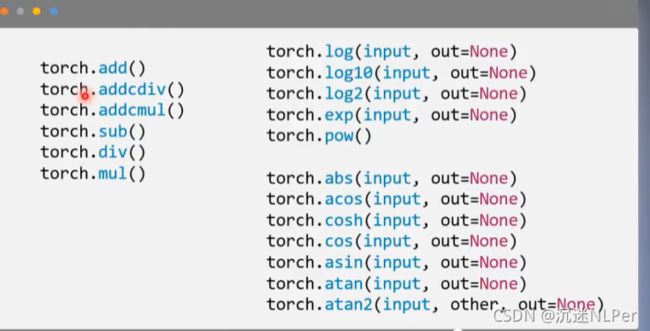pytorch-1
pytorch-1
- pytorch
- 张量(Tensor)
- tensor与variable
- 张量操作
- 张量的数学运算
pytorch
Torch是一个与Numpy类似的张量(Tensor)操作库,与Numpy不同的是Torch对GPU支持的很好,Lua是Torch的上层包装。
PyTorch和Torch使用包含所有相同性能的C库:TH, THC, THNN, THCUNN,并且它们将继续共享这些库。
PyTorch是一个基于Torch的Python开源机器学习库。
PyTorch是一个Python包,提供两个高级功能:
- 具有强大的GPU加速的张量计算(如NumPy)
- 包含自动求导系统的的深度神经网络
张量(Tensor)
张量,即tensor,是pytorch中的基本运算单位,与numpy中的ndarray相同是一个多维矩阵,但与ndarray的最大区别是,tensor可以在GPU上运行,大大提高运算速度,而ndarray只能在CPU上运行。
令r为张量的秩或阶,当r=0(第零阶张量)时为标量,当r=1(第一阶张量)时为向量量,当r=2(第二阶张量)时为矩阵,第三阶及以上的张量统称为张量。
张量的基本数据类型有五种:
- 64位浮点型:torch.float32/torch.folat
- 32位浮点型 :torch.float64/torch.double
- 16位浮点型:torch.float16/torch.half
- 8位无符号整型:torch.uint8
- 64位整型:torch.int64/torch.long
- 32位整型:torch.int32/torch.int
- 16位整型:/torch.int16/torch.short
tensor创建方法:
- 直接创建,即torch.tensor()
torch.tensor(
data,
dtype=None,
device=None,
requires_grad=False,
pin_memory=False)
# data:数据,可以是list,numpy
# dtype:数据类型,默认与data一致
# device:所在设备,GPU/CPU
# requires_grad:是否需要梯度
# pin_memory: 是否存于锁页内存
torch.tensor(23)
torch.tensor([1.2,23.0,25.6])
torch.tensor([[1.2,23.0,25.6],[1.2,23.0,25.6]])
- 从numpy创建tensor
torch.from_numpy(ndarray)
# 注:torch.from_numpy创建的tensor与原ndarray共享内存,当修改其中一个数据时,另一个也会被改变。
arr = numpy.array([[1.2,23.0,25.6],[1.2,23.0,25.6]])
t = torch.from_numpy(arr)
- 依据数据创建tensor
# 1 创建全0张量
torch.zeros(
*size,
out=None,
dtype=None,
latout=torch.strided,
device=None,
requires_grad=False)
# size: 张量的形状,如3,3/3,22,22 *size会自动将输入的维度数值打包成元组。
# out:输出的张量
# layout:内存中布局形式,有strided,sparse_coo等
# device:所在设备,CPU/GPU
# requires_grad:是否需要梯度
# dtype:数据类型。
# 2 依据其他数据的形状创建全0张量
torch.zeros_like(
input,
dtype=None,
layout=None,
device=None,
requires_grad=False)
# input:创建与input形状一致的全0张量
# dtype: 数据类型
# layout:内存中的布局形式
# 3 创建全1张量
torch.ones(
*size,
out=None,
dtype=None,
latout=torch.strided,
device=None,
requires_grad=False)
torch.ones_like(
input,
dtype=None,
layout=None,
device=None,
requires_grad=False)
# 4 依据数值创建全-张量
torch.full(
size,
fill_value,
out=None,
dtype=None,
layout=torch.strided,
device=None,
requires_grad=False)
# size,张量形状,()元组输入
# fill_value: 填充张量的值
torch.full_like(
input,
fill_value
)
# 5 创建等差的1维张量
torch.arange(
start=0,
end,
step=1,
out=None,
dtype=None,
layout=torch.strided,
device=None,
requires_grad=False)
# 数值区间为 [start,end) 左闭右开
# start:数量起始值
# end:数量结束值(不包括)
# step:数量公差(步长)
# 6 创建均方的1维张量
torch.linspace(
start,
end,
steps=100,
out=None,
dtype=None,
layout=torch.strided,
device=None,
requires_grad=False)
# 数值区间维 [start, end] 左闭右闭区间
# start: 数列起始值
# end: 数量结束值(包括)
# steps: 数列长度
# 其步长为 (end-start)/(steps-1)
# 7 创建对数均分的1维张量
torch.logspace(
start,
end,
steps=100,
base=10.0,
out=None,
dtype=None,
layout=torch.strided,
device=None,
requires_grad=False)
# 数值区间维 [start, end] 左闭右闭区间
# 长度为steps,底为base
# start: 数列起始值
# end: 数量结束值(包括)
# steps: 数列长度
# base:对数函数的底,默认为10
# 8 创建单位矩阵
torch.eye(
n,
m=None,
out=None,
dtype=None,
layout=torch.strided,
device=None,
requires_grad=False)
# 创建单位对角矩阵(2维张量)
# n为矩阵行数
# m为矩阵列数
- 依据概率分布创建张量
# 1 正态分布 (高斯分布)
torch.normal(
mean,
std,
out=None)
# mean 均值
# std:标准差
# 四种模式:mean为标量,std为标量;mean为张量,std为标量;mean为标量,std为张量;mean为张量,std为张量
# 2 创建标准正太分布(均值为0,标准差为1)
torch.randn(
*size,
out=None,
dtype=None,
latout=torch.strided,
device=None,
requires_grad=False)
# size:张量的形状
torch.randn_like()
# 3 创建均匀分布
torch.rand(
*size,
out=None,
dtype=None,
latout=torch.strided,
device=None,
requires_grad=False)
torch.rand_like()
# 创建区间为[0, 1)的均匀分布
torch.randint(
low=0,
high,
size,
out=None,
dtype=None,
latout=torch.strided,
device=None,
requires_grad=False)
torch.randint_like(
input,
low,
high)
# 在区间[low, high)生成整数均匀分布
# 4 创建伯努利分布
torch.bernoulli(
input,
*,
generator=None,
out=None)
# 以input为概率,生成伯努利分布
# 5 生成随机排列
torch.randperm(
n,
out=None,
dtype=None,
latout=torch.strided,
device=None,
requires_grad=False)
# 生成从0到n-1的随机排列
tensor与variable
variable是torch.autograd中的数据类型,主要用于封装tensor,进行自动求导。
variable的五个属性:
- data:被封装的tensor
- grad:data的梯度
- grad_fn:创建tensor的function,是自动求导的关键
- requires_grad:指示是否需要梯度
- is_leaf:指示是否是叶子结点(张量)
现版本已将variable并于tensor中,
torch.Tensor()的属性

torch.Tensor和torch.tensor的区别
在Pytorch中,Tensor和tensor都用于生成新的张量。
torch.Tensor()是Python类,更明确的说,是默认张量类型torch.FloatTensor()的别名,torch.Tensor([1,2]) 会调用Tensor类的构造函数__init__,生成单精度浮点类型的张量。
torch.tensor()仅仅是Python的函数
张量操作
- 拼接
将张量按维度dim进行拼接
cat不会对tensor的维度进行扩张,stack则会
torch.cat(
tensors,
dim=0,
out=None)
# tensors:张量序列 []
# dim:拼接维度
torch.stack(
tensors,
dim=0,
out=None)
# 在新创建的维度dim上进行拼接
- 切分
torch.chunk(
input,
chunks,
dim=0)
# 将张量按维度dim进行平均切分,返回一张量列表
# 注:若不能整除,最后一份张量小于其他张量
# input: 要切分的张量
# chunks:要切分的分数
# dim:要切分的维度
torch.split(
tensor,
split_size_or_sections,
dim=0)
# 将张量按维度dim进行切分,返回张量列表
# tensor:要切分的张量
# split_size_or_sections: 为int时,表示每份的长度;为list时,按list元素进行切分
# dim:要切分的维度
- 张量索引
torch.index_select(
input,
dim,
index,
out=None)
# 在维度dim上,按index索引数据返回值即依据index索引数据拼接的张量
# input: 要索引的张量
# dim: 要索引的维度
# index:要索引数据的序号
torch.masked_select(
input,
mask,
out=None)
# 按mask中的True进行索引,返回一维张量
# input: 要索引的张量
# mask:与input同形状的布尔型张量
- 张量变换
torch.reshape(
input,
shape)
# 变换张量形状
# input: 要变换的张量
# shape: 新张量的形状
# 注: 当张量在内存中是连续时,新张量与input共享数据内存
torch.transpose(
input,
dim0,
dim1)
# 交换张量的两个维度
# input: 要变换张量
# dim0:交换维度0
# dim1:交换维度1
torch.t(input)
# 2维张量转置
torch.squeeze(
input,
dim=None,
out=None)
# 压缩长度为1的维度(轴)
# dim: 若为None,移除所有长度为1的轴;若指定维度,当且仅当该轴长度为1时进行移除
torch.unsqueeze(
input,
dim,
out=None)
# 依据dim扩展维度
# dim:扩展的维度
张量的数学运算
torch.add(
input,
alpha=1,
other,
out=None) # 逐元素计算,input+alpha*other
torch.addcdiv(
input,
value=1,
tensor1,
tensor2,
out=None)# 逐元素计算,input+value*tensor1/tensor2
torch.addcmul(
input,
value=1,
tensor1,
tensor2,
out=None)# 逐元素计算,input+value*tensor1*tensor2
